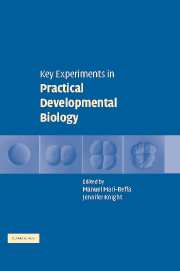Book contents
- Frontmatter
- Contents
- List of contributors
- Preface
- Introduction
- SECTION I GRAFTINGS
- SECTION II SPECIFIC CHEMICAL REAGENTS
- SECTION III BEAD IMPLANTATION
- SECTION IV NUCLEIC ACID INJECTIONS
- SECTION V GENETIC ANALYSIS
- SECTION VI CLONAL ANALYSIS
- SECTION VII IN SITU HYBRIDIZATION
- SECTION VIII TRANSGENIC ORGANISMS
- 19 Bicoid and Dorsal: Two transcriptions factor gradients which specify cell fates in the early Drosophila embryo
- 20 Significance of the temporal modulation of Hox gene expression on segment morphology
- 21 The UAS/GAL4 system for tissue-specific analysis of EGFR gene function in Drosophila melanogaster
- 22 Neurogenesis in Drosophila: A genetic approach
- 23 Role of the achaete-scute complex genes in the development of the adult peripheral nervous system of Drosophila melanogaster
- SECTION IX VERTEBRATE CLONING
- SECTION X CELL CULTURE
- SECTION XI EVO–DEVO STUDIES
- SECTION XII COMPUTATIONAL MODELLING
- Appendix 1 Abbreviations
- Appendix 2 Suppliers
- Index
- Plate Section
- References
22 - Neurogenesis in Drosophila: A genetic approach
Published online by Cambridge University Press: 11 August 2009
- Frontmatter
- Contents
- List of contributors
- Preface
- Introduction
- SECTION I GRAFTINGS
- SECTION II SPECIFIC CHEMICAL REAGENTS
- SECTION III BEAD IMPLANTATION
- SECTION IV NUCLEIC ACID INJECTIONS
- SECTION V GENETIC ANALYSIS
- SECTION VI CLONAL ANALYSIS
- SECTION VII IN SITU HYBRIDIZATION
- SECTION VIII TRANSGENIC ORGANISMS
- 19 Bicoid and Dorsal: Two transcriptions factor gradients which specify cell fates in the early Drosophila embryo
- 20 Significance of the temporal modulation of Hox gene expression on segment morphology
- 21 The UAS/GAL4 system for tissue-specific analysis of EGFR gene function in Drosophila melanogaster
- 22 Neurogenesis in Drosophila: A genetic approach
- 23 Role of the achaete-scute complex genes in the development of the adult peripheral nervous system of Drosophila melanogaster
- SECTION IX VERTEBRATE CLONING
- SECTION X CELL CULTURE
- SECTION XI EVO–DEVO STUDIES
- SECTION XII COMPUTATIONAL MODELLING
- Appendix 1 Abbreviations
- Appendix 2 Suppliers
- Index
- Plate Section
- References
Summary
OBJECTIVE OF THE EXPERIMENT The objective of these experiments is to understand some of the major principles underlying neural development by applying classic and modern genetic experimental techniques to this problem. In this chapter we will study (1) the neural and ectodermal phenotypes of different mutations, (2) the use of classic loss-of-function and conditional alleles with modern gain-of-function techniques, and (3) genetic interactions that allow the determination of epistatic relationships among genes.
DEGREE OF DIFFICULTY Moderate. The experiments require some experience in the handling of flies and in the preparation of microscope slides for cuticle preparations and whole-mount antibody staining.
INTRODUCTION
The precisely regulated formation of neurons and glial cells is of obvious importance during development of higher metazoan organisms. Work over the last few decades has led to the initially surprising finding that invertebrates and vertebrates utilize very similar molecular mechanisms to elaborate a functional nervous system.
In all animals, neural tissue develops from the ectoderm. This raises the question of how ectodermal cells are initially routed towards the neural fate and how the correct number of neural founder cells is established in a stereotyped pattern. Pioneering work on Drosophila neurogenesis has set the stage for efficient molecular dissection of neural development.
THE PROCESS
During the blastoderm stage, positional information is translated to define the neurogenic ectoderm that resides between the mesodermal anlage and the future dorsal ectoderm (Figure 1a). In addition, a domain that will give rise to the brain is set aside as the procephalic ectoderm.
- Type
- Chapter
- Information
- Key Experiments in Practical Developmental Biology , pp. 282 - 295Publisher: Cambridge University PressPrint publication year: 2005



